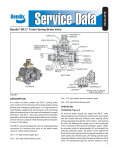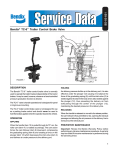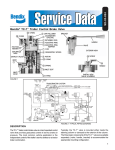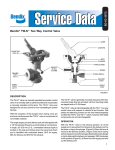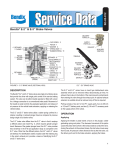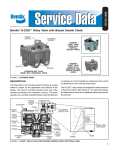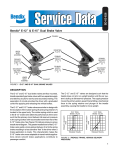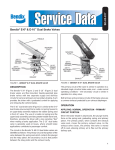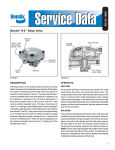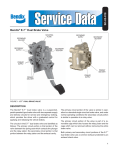Download BENDIX BW1566 User's Manual
Transcript
SD-03-4503 ® Bendix® TC-4™ Modulating Control Valve EXHAUST PORT DELIVERY PORT DELIVERY PORT FIGURE 1 SUPPLY PORT TC-2™ VALVE TP-2™ VALVE COUPLINGS TW-1™ VALVE TC-2™ VALVE DS-1 ™ SV-1 VALVE GAUGE BRAKE CHAMBERS TRAILER SERVICE TRAILER EMERGENCY MANIFOLD SPRING BRAKES E-3™ BRAKE VALVE RELAY VALVE QR-1™ VALVE COMPRESSOR GOVERNOR QR-1™ VALVE PARKING & EMERGENCY RESERVOIR SINGLE CHECK VALVE SAFETY VALVE SUPPLY RESERVOIR SERVICE RESERVOIR FIGURE 2 DRAIN COCK DRAIN COCK SINGLE CHECK VALVE TYPICAL PIPING DIAGRAM 7 LEVER PIN 9 8 TORSION SPRING O-RING 15 PLUNGER 10 PISTON RETURN SPRING 14 SHIM 12 GRADUATING SPRING MACHINE SCREW 16 O-RING 6 DISC 13 PISTON 5 LOCKING BUTTON BODY VALVE 4 VALVE SPRING 5 CAP NUT SEALING RING 2 CAP NUT 1 FIGURE 3 2 DESCRIPTION PREVENTIVE MAINTENANCE The TC-4™ modulating control valve is a cam operated, graduating type control valve. The valve is used to control the application and release of spring brake actuators, and is generally mounted in the cab within easy reach of the driver. Important: Review the Bendix Warranty Policy before performing any intrusive maintenance procedures. A warranty may be voided if intrusive maintenance is performed during the warranty period. Modulated control of the emergency brakes (spring brakes) is effected by moving the valve’s spring loaded lever. Moving the lever against the resistance of the spring applies the brakes and, allowing the valve handle to return, releases the brakes. No two vehicles operate under identical conditions, as a result, maintenance intervals may vary. Experience is a valuable guide in determining the best maintenance interval for air brake system components. At a minimum, the TC-4™ valve should be inspected every 6 months or 1500 operating hours, whichever comes first, for proper operation. Should the TC-4™ valve not meet the elements of the operational tests noted in this document, further investigation and service of the valve may be required. When the valve is used for parking, the locking button is moved into the locked position after the handle has been moved to the “Brakes Applied” position. The lever is now mechanically locked in position. To release the lever, the lever is slightly depressed, the lock button moved out of the locked position and the lever returned to the “Brakes Released” position. Porting consists of one (1) supply port, two (2) delivery and two (2) exhaust ports. OPERATION Reference Figure 2, the TC-4™ valve is generally used in conjunction with a relay valve to control the application and release of the spring brakes. In a typical system, the TC-4™ valve and the relay valve receive supply air from the emergency/parking reservoir. RELEASED POSITION (Spring Brakes Released) In the normal run position, air enters the supply port of the TC-4™ valve, flows by the open inlet valve and out the delivery port. Air flows to the service (control) port of the relay valve causing the relay valve to deliver air to the spring brakes, holding them in the released position. APPLY POSITION (Spring Brakes Applied) Moving the lever to the apply position allows the inlet valve to close and the exhaust passage to open. This allows the air being delivered to the service (control) port of the relay valve to exhaust to atmosphere (through the exhaust of the foot brake valve). With air exhausted from the service (control) port of the relay valve, the relay valve responds, exhausting the air from the spring brakes (allowing the brakes to apply). With sufficient air pressure in the emergency/parking reservoir, modulation of the spring brake application is possible; the amount of braking force governed by the position of the TC-4™ valve lever. With reference to Figure 2, note that the exhaust of the TC-4™ valve is connected to a delivery line of the foot brake valve. This prevents the compounding of spring brake and service brake application forces on the slack adjusters. Check for proper operation before placing vehicle in operation. OPERATING AND LEAKAGE TESTS If valve is to be tested on vehicle, block the vehicle wheels. Build system pressure to approximately 100 psi and place lever to “apply” position and observe that spring brakes apply. With lever in apply position, lock lever in place with locking button. Coat exhaust port with soap solution; leakage should not exceed a 1" bubble in less than 5 seconds. (NOTE: If line is connected to exhaust port, disconnect line or remove pipe plug from other exhaust port.) Excessive leakage would indicate a faulty inlet valve. Release locking button and place lever in release position; observe that brakes fully release. Coat exhaust port with soap solution; leakage should not exceed a 1" bubble in not less than 5 seconds. Excessive leakage would indicate exhaust valve or lower o-ring leakage. (If line at exhaust port was disconnected, connect line and/or tighten fitting or pipe plug.) Remove dial; while making a full foot valve application, coat top of valve with soap solution. Leakage permitted is a 1" bubble in not less than 5 seconds. Excessive leakage would indicate upper o-ring leakage. (If line is not connected to exhaust port, it will be necessary to apply 100 psi to the exhaust port to check for upper o-ring leakage.) Soap area around supply port cap nut to check for cap nut o-ring leakage. No leakage permitted. Blow out or dry all soap solution and replace dial. To check modulation of valve, it will be necessary to test while vehicle is in motion. Select a suitable location to perform braking test. With vehicle in motion, apply the TC-4™ valve several times. 3 NOTE: The valve is correctly modulating the brake application. 2. Install shims (11 ) and graduating spring (12). If the valve does not function as described, or if leakage is excessive, it is recommended that it be replaced with a new or remanufactured unit or repaired with genuine Bendix parts available at Bendix outlets. 4. Install piston return spring (14) on piston; holding this assembly vertical, place the body over the top of the piston assembly, then turn over letting the assembly fall into place. REMOVING AND INSTALLING 5. Install the torsion spring (8) over the lever (7) noting that parts are in correct relation to body as previously marked. REMOVING Block and hold vehicle by means other than air brakes. Drain all air brake system reservoirs. Identify air lines to TC-4™ valve to facilitate installation; disconnect lines. Remove mounting screws, then valve. 3. Install piston (13) on plunger (10). 6. Place the ends of the torsion spring (8) in holes in the body. Install pin (9) and center in place. 7. Check for correct handle assembly by noting the torsion spring and handle assembly will move the piston past the inlet seat surface. (This can be seen by looking at the supply port end of the valve.) If handle is not assembled into body correctly, reassemble. 8. Install inlet valve (4) and inlet valve spring (3). INSTALLING Clean air lines to valve. Mount valve securely with two mounting screws. Identify and connect air lines to valve. DISASSEMBLY (Refer to Figure 3) 9. Install sealing ring (2) on cap nut (1); install cap nut (Torque to 50-100 inch pounds.) 10. Install disc (6) in locking button (5) and install button into valve. 11. Test valve as outlined in “Operating and Leakage Test” section. 1. Remove cap nut (1) and cap nut sealing ring (2). 2. Remove inlet valve spring (3) and inlet valve (4). 3. Remove locking button (5) and rubber friction disc (6). 4. Mark lever (7) in relation to body and torsion spring (8) in relation to handle so that proper position can be determined during assembly. 5. Using a small drift, carefully remove pin (9), lever (7) and spring (8). 6. Remove plunger (10), shims (11) (if present), graduating spring (12), piston (13) and piston return spring (14). 7. Remove o-rings (15 and 16) from plunger (10) and piston (13). CLEANING AND INSPECTION Wash all metal parts in mineral spirits. Wipe all rubber parts dry. Inspect all parts for signs of wear or deterioration; check springs for cracks, corrosion or distortion. Inspect piston and inlet and exhaust seat for nicks or burrs. It is recommended that all rubber parts and any other part showing signs of wear or deterioration be replaced. ASSEMBLY Prior to assembly, lubricate the piston, o-rings and body bores with Dow Corning 55-M pneumatic grease (Bendix Pc. No. 291126). 1. Install o-rings (15 & 16) on plunger (10) and piston (13). WARNING! PLEASE READ AND FOLLOW THESE INSTRUCTIONS TO AVOID PERSONAL INJURY OR DEATH: When working on or around a vehicle, the following general precautions should be observed at all times. 1. Park the vehicle on a level surface, apply the parking brakes, and always block the wheels. Always wear safety glasses. 2. Stop the engine and remove ignition key when working under or around the vehicle. When working in the engine compartment, the engine should be shut off and the ignition key should be removed. Where circumstances require that the engine be in operation, EXTREME CAUTION should be used to prevent personal injury resulting from contact with moving, rotating, leaking, heated or electrically charged components. 3. Do not attempt to install, remove, disassemble or assemble a component until you have read and thoroughly understand the recommended procedures. Use only the proper tools and observe all precautions pertaining to use of those tools. 4. If the work is being performed on the vehicle’s air brake system, or any auxiliary pressurized air systems, make certain to drain the air pressure from all reservoirs before beginning ANY work on the vehicle. If the vehicle is equipped with an AD-IS™ air dryer system or a dryer reservoir module, be sure to drain the purge reservoir. 5. Following the vehicle manufacturer’s recommended procedures, deactivate the electrical system in a manner that safely removes all electrical power from the vehicle. 6. Never exceed manufacturer’s recommended pressures. 7. Never connect or disconnect a hose or line containing pressure; it may whip. Never remove a component or plug unless you are certain all system pressure has been depleted. 8. Use only genuine Bendix ® replacement parts, components and kits. Replacement hardware, tubing, hose, fittings, etc. must be of equivalent size, type and strength as original equipment and be designed specifically for such applications and systems. 9. Components with stripped threads or damaged parts should be replaced rather than repaired. Do not attempt repairs requiring machining or welding unless specifically stated and approved by the vehicle and component manufacturer. 10. Prior to returning the vehicle to service, make certain all components and systems are restored to their proper operating condition. BW1566 © 2004 Bendix Commercial Vehicle Systems LLC. All rights reserved. 4/2004 Printed in U.S.A.





